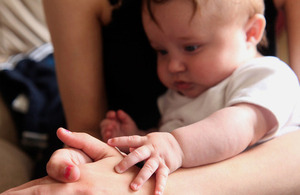Breastfeeding initiation high in London but drop-off rates could be improved
A new report published today (Friday 30 August) by PHE shows that breastfeeding rates in London are higher than England and have risen since 2005.

Mother and baby
In London, women from black ethnic backgrounds and mothers born outside of the UK are significantly more likely to breastfeed despite many living in deprived circumstances. Young mothers in London are significantly less likely to breastfeed than older mothers and areas with predominantly white British communities have higher drop-off rates.
The report includes the following key findings:
-
87% of mothers in London initiated breastfeeding in the first few days after birth compared to 74% for England
-
the percentage of mothers in London initiating breastfeeding has risen significantly in recent years
-
despite high levels of breastfeeding initiation in London there was variation across boroughs with rates ranging from 94% to 71%
-
68% of mothers in London partially or exclusively breastfed 6 to 8 weeks after birth compared to 47% for England
-
by 6 to 8 weeks after birth, 40% of mothers in London breastfed exclusively compared to 32% for England
-
the ‘drop-off’ rate for mothers ceasing to breastfeed 6 to 8 weeks after birth was 23% in London compared to 36% for England. However, drop-off rates across London ranged from 9% to 32%
Dr Yvonne Doyle, regional director for Public Health England (PHE) London, said:
Breastfeeding is free and known to provide multiple health benefits for both mother and child which extend into adulthood. It is great news that London mothers are more likely to start breastfeeding than those in other parts of the country and this may be due to effective local initiatives or that London has a number of minority communities who are leading the way.
There is an opportunity to create a breastfeeding-friendly city in London but ongoing work is needed locally to integrate breastfeeding initiatives with wider public health strategies and with other local services for mothers and babies.
Despite these encouraging rates, improvements in breastfeeding are still needed in some areas in London, particularly in the inequalities that exist between mothers from different backgrounds.
The report shows that many women who start to breastfeed are often not continuing to do so two months after the birth. It is also important to note that a large proportion of women who breastfeed when their baby is born do not do so exclusively and may top up breastfeeding with formula milk. Exclusive breastfeeding is recommended for the first 6 months of a baby’s life and the challenge now is to provide a culture and environment in London that reduces drop-off rates and supports mothers to breastfeed exclusively.
Ends
Notes to editors:
-
The full report - ‘Progress in Breastfeeding in London: 2013 report’ - will be available on the PHE London Knowledge and Intelligence Team website on Friday 30 August.
-
The PHE London Knowledge and Intelligence Team (formerly the London Health Observatory) together with the former London Health Improvement Board (LHIB) conducted a joint initiative to analyse breastfeeding data, examine local evidence and share local breastfeeding practice in London. The ‘Progress in Breastfeeding in London: 2013 report’ is the outcome of that work.
-
Particular local initiatives may explain the high initiation and prevalence rates of partial breastfeeding in London but nearly all are unevaluated and their impacts unknown.
-
Methodology: a semi-structured survey was sent to London breastfeeding leads in acute NHS trusts and former primary care trusts (PCT). Survey responses were combined with an internet literature review for each London PCT, local authority and acute NHS trust.
-
Breastfeeding definitions: ‘Initiation’ - the percentage of mothers who put their baby to the breast or give any breast milk within the first 48 hours of birth. ‘Prevalence’ - the percentage of mothers who are giving their babies breast milk at 6 to 8 weeks of age. Infants may also be receiving formula milk or any other liquids or food. ‘Exclusive breastfeeding’ - the percentage of mothers who are only giving their babies breast milk at 6 to 8 weeks of age. Infants are NOT receiving formula milk, any other liquids or food. ‘Breastfeeding drop-off’ - the percentage of mothers initiating breastfeeding minus the percentage of infants being breastfed at 6 to 8 weeks, divided by the percentage of mothers initiating breastfeeding.
-
More information about breastfeeding is available on the NHS Choices website.
-
Public Health England’s mission is to protect and improve the nation’s health and to address inequalities through working with national and local government, the NHS, industry and the voluntary and community sector. PHE is an operationally autonomous executive agency of the Department of Health.
UK Health Security Agency press office
10 South Colonnade
London
E14 4PU
]